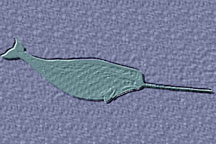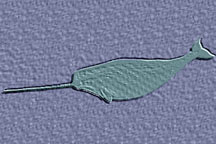![]()
 |
Critter Watch By Richard MartinDive Legends-The Tusked Narwhal |
 |
| |
We are all influenced by our desires. But some people want to believe certain things so desperately, they will hold onto those beliefs no matter how flimsy the evidence. From Medieval times until the early 1700's, the existence of legendary unicorn seemed to be supported by the splendid, spiraling horns that intrepid sailors brought back to Europe. By now, most of us have heard that these horns came from a quite real but elusive animal, the narwhal.
The narwhal is characterized by a rounded head with a very short rostrum, a sausage-shaped body, pectoral flippers upturned at the tips, and tail flukes that often look as though they were stuck on backward (this effect becomes more pronounced with age). After a gestation period of about 15 months, the young are born about five feet long and weighing 175 pounds. Newborn narwhals are a blotchy brownish grey, but by the time they are weaned at 18 to 20 months, they are uniformly purplish black; during adolescence, white patches begin to appear. Females become sexually mature after five years at about 12 feet long and 1 600 pounds, males mature after eight years at about 16 feet and 1.6 tons. At maturity, both sexes are greyish with black or dark brown smudges; very old animals (25 to 30 years of age or older) can be almost entirely white. The most obvious characteristic of the mature males, however, is the spectacular tusk, which has puzzled naturalists for centuries.
All narwhals have two teeth in the upper jaw. When males are about a year old, the left tooth erupts through the upper lip to become the tusk (in about 1 in 500 males, both teeth erupt to form a double tusk). As the narwhal grows, its tusk increases in length and spirals counter-clockwise (when viewed from the base). The lip at the base of the tusk never seems to heal and is often infested with several pounds of ectoparasites. The tusk may grow to 9 3/4 feet long, have a girth at the base of 12 inches, and weigh up to 22 pounds. The tusk is hollow for most of its length and quite brittle; in roughly one third of individuals, the tusk is broken. The tip of the tusk is brilliant white and usually polished smooth.
What is the purpose of the narwhal's tusk? All kinds of theories have been put forward to explain the function of this champion overbite. It has been suggested, for example, that the tusk is used for poking breathing holes in the ice, but observations have shown that narwhals use their rounded foreheads for this purpose. Others have suggested that the narwhal tusk may be used as a weapon against its predators (polar bears, killer whales, and Greenland sharks), but it is hard to believe the fragile tusk would prove a durable weapon (recalling the old joke: "Q: Can an elephant jump? A. Yes, but only once."). Still others have suggested that the tusk is used to heard small schooling prey (Arctic cod or squids) or prod benthic creatures (crustaceans) from the bottom muck. This is feasible, but the largely sympatric and closely-related beluga manages similar prey just fine without such dental equipment.
The most likely function of the narwhal tusk, however, is as an aid to establishing dominance among rival males. Male narwhals have been documented jousting with crossed tusks, both above and below water. The sound of these conflicts is like two wooden walking sticks being repeatedly banged together. Young males frequently playfight, but rarely spear each other; older males are often seriously scarred after more earnest battles over females - but they, too, rarely spear one another. More than two animals may be involved in such fights, and sometimes others (of either sex) may 'observe' scuffles; it is possible that subadult male narwhals may learn about jousting by watching older males, or that females watch as the males show off in an attempt to win favour.
One of the most interesting theories has been advanced by Canadian scientist Peter Beamish. Narwhals are highly vocal, producing clicks, squeals, growls and whistles; the clicks are narrow-band, pulsed sounds with a frequency of 15-24 kHz. Beamish noticed that the tusks throbbed in a disturbing way when the males were producing their highest frequencies, and he suggests that they may be wave guides which channel the sounds and focus them into tight, directional beams. The sound frequencies recorded for narwhals could be sonar pulses, but they seem to show no variation with approach to obstacles. In the case of males, however, the tusk may conduct sound energy sufficiently close to a rival male's sensitive ears to cause considerable discomfort. A solid tusk would conduct sound energy more efficiently than a hollow one but, as noted above, most mature males have badly scarred heads consistent with tusk-tip slashes. This opens up the intriguing possibility of competing male narwhals fighting acoustic duels, lashing at each other with their sonic lances ("MWONGGGG!! ... MWONGGG!! Use the Force, Luke!").
What is it like to dive with narwhals? Two intrepid Canadian film-makers are among the lucky few who have had opportunity to climb in the water with free-swimming narwhals (all attempts to maintain this species in captivity have failed within a few weeks of capture). As part of independent film projects, Pauline Heaton and Adam Ravich have dived with narwhals during the summer in Lancaster Sound, off Baffin Island. Although Pauline told me that from atop the ice flow, she could often get within two feet of passing narwhals - "a cinematographer's dream!" - both she and Adam report that narwhals are skitterish and reluctant to approach a snorkeler or a submerged diver. Pauline told me she could approach to a distance of about 20 feet, but would not be tolerated any closer; freshwater melt often reduced underwater visibility to that 'gin-and-tonic' effect coldwater divers know so well. Adam believes that the whales' sonar alerts them almost instantly to a diver's approach from almost any direction.
Both Pauline and Adam agree that the narwhals seem to follow open channels, either made by icebreakers or natural polinyas. I asked each of them whether they could hear the whales vocalize; they both said that if the whales were making sounds underwater, they couldn't hear it. According to Pauline, the narwhals often swam in small pods of 5 to 20 whales (consisting mostly of females, but with usually with one or two tuskers as well), arranged in straight rows. Adam told me of groups of up to 200 narwhals, comprised of pods of 4 to 6 individuals; some of these pods were one-sex, but most were mixed. He did not notice any sex play or mating behavior among the narwhals. Unlike many larger whales, narwhals rarely lift their flukes out of the water - except preceding exceptionally deep dives. The duration that narwhals spend underwater each dive typically varies from 7 to 20 minutes; after particularly long dives, a group of narwhals may rest at the surface for up to 10 minutes.
No matter how long a diver is able to spend with narwhals, the memories will last a lifetime. But few are willing to suffer the daunting expense, exhausting travel, and intense cold for a chance to catch a brief, ghost-like glimpse of these mysterious creatures in the context of their natural habitat. The desire must be strong enough for one to endure the hardships and crystallize such a dream into actuality. For those who do, the experience of encountering a diving legend must surely rank among the purest and most perfect of adventures.